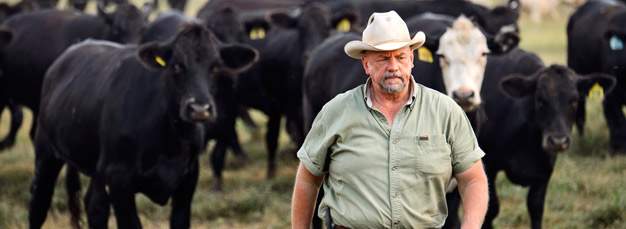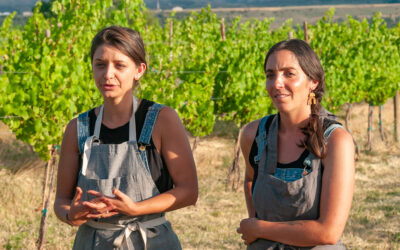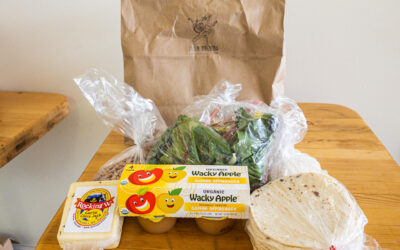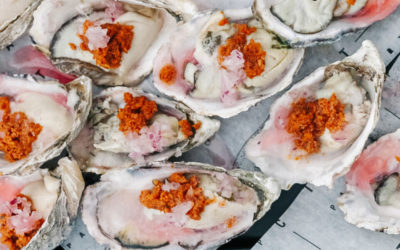
“Hop in,” Will Harris said, as he quickly cleared off the passenger seat of his battered Jeep, placing an old shotgun in back. He clamped his Stetson onto his bald head and steered down the dusty road and into the pasture. Nowhere is Harris happier than he is here: surveying the 2,500 acres of White Oak Pastures, the farm his great-grandfather established in this southwest corner of Georgia in 1866.
“This land is teeming with life,” the 59-year-old says in a seductive, Southern drawl so deep that the word “life” has two—maybe three—syllables. Harris is referring not only to the farm’s cattle, hogs, sheep, goats, chickens, turkeys and ducks, but also its diverse grasses and its red soil, alive with healthy microbes. As we bump past the mama cows swinging their tails in the fading light, Harris tries to tell me the story of the farm’s transformation. But he keeps getting distracted: He points out a hawk swooping below the puffy, pink clouds and a flock of guinea hens scurrying across a field. Several times, he slows down enough to sigh at just how pretty it all is.
White Oak Pastures is often held up as a model of sustainability, and for good reason. Its cattle are 100 percent grass-fed and slaughtered at a certified-humane abattoir on the farm. Harris uses a rotational grazing system so that the parade of cows, sheep and poultry benefit from the dozens of different grasses that make up the pasture, and in turn improve it by replenishing it with nutrients. But it was not always this way. Less than 20 years ago, this was a conventional cattle farm, one that relied on chemical fertilizers and pesticides for its fields and hormones, antibiotics and corn for its animals. Until the day that Harris decided everything had to change.
The Business of Beef
Grass-fed beef currently makes up less than 3 percent of U.S. sales. But the industry has grown 25 percent annually in each of the last 10 years. So far, mostly smaller producers have made the switch, raising dozens rather than hundreds of head a year. In contrast, Harris raises 700 each year. “Will’s is a great success story,” says Allan Nation, editor of The Stockman Grass Farmer, a magazine that is the bible for pasture-raised livestock producers. “It’s multigenerational and he’s achieved scale. That helps a lot.”
When Harris’s great-grandfather, James Edward Harris, started White Oak Pastures in Bluffton, Georgia, it was a subsistence farm. Every week, Harris and 80 emancipated slaves killed a cow, some hogs—whatever was ready to eat. It was his son, Will Carter Harris, who expanded the farm. He added livestock, and eventually produced most of the meat for Bluffton’s 400 residents. Will Carter Harris was so successful as an entrepreneur that he created his own currency that was used widely through town until sometime after World War II, when a representative of the U.S. Treasury showed up to put a stop to it.
The end of the war brought other important changes too. Factories that had once pumped out munitions were now making chemical fertilizers, and chemical companies that had brewed nerve gas started to sell new, powerful pesticides. Cattlemen like Harris’s father also embraced new animal husbandry techniques: the routine use of antibiotics, artificial insemination and hormone implants to make the animals grow faster. Farming, which had been more or less the same for 10,000 years, had transformed. It was now a business that was expected to deliver regular, highly measurable financial returns. “The males of my family are very alpha-linear, Western, more-is-better—we’re those assholes,” Harris says with a laugh. “And we assholes make great industrial farmers. That’s the skill set.”
In the mid-1990s, however, Harris’s drive to squeeze more profits out of his cattle at a faster rate began to fade. It wasn’t one moment—it was more a kind of fatigue: “If the label instructions say to put one hormone implant behind that cow’s ear, guess how many I was gonna put there? If the label instructions said, put a quart of that to the acre, guess how much I put? So I was the guy that was always doing more and more and cheating and swindling. It just got disgusting.”
Harris never intended a radical makeover of his farm; there was no “burning bush” moment, as he likes to say. But the changes Harris made were in fact sweeping, perhaps a result of his trademark driven approach to farming. His first step was to transition to organic, which he began in 1995, the same year he took over the farm from his father. With the switch to organic he stopped using hormones and antibiotics. Then, he decided that for the healthiest cattle he needed to grow the best grass. So he adopted a new multi-animal grazing system based on one used in Africa’s Serengeti. To provide the animals the dignified end they deserve, he realized, it would be best to have a certified-organic and certified-humane slaughterhouse right on the farm.
A Different Way
Twenty years ago, the lifespan of a steer born on Harris’s farm was 16 months. Calves were weaned at six months, lived on a diet of grass and grain for another five before being sent to a feedlot, where they binge-fed on corn and gained between three and four pounds a day. At the time, the system made sense to him. It was the way his father had done it and the way Harris had been taught at the University of Georgia, where he got his degree in animal husbandry. But cattle are ruminants, which means their stomachs can’t properly digest corn. And the long truck journey to the feedlot was unsanitary and stressful for the animals—as was their destination. “Sending cattle to a feedlot is like raising your daughter to be a princess and then sending her off to the whorehouse,” Harris says.
Today, his cattle are weaned at eight months and spend the next 14 months munching on the farm’s mix of seasonal grasses, including bahiagrass, dallisgrass, Johnson grass, white clover and cereal rye. When their time comes, the animals walk to the farm’s on-site slaughterhouse. The differences between the industrial and grass-fed methods illuminate why Harris’s beef sells for a premium. Pasture-raised animals live almost 40 percent longer and still weigh between 20 and 30 percent less at slaughter than feedlot-fed animals. In short: it costs more to produce every pound of meat.
The transformation of White Oak Pastures has earned Harris plenty of acclaim. He was Georgia’s Small Business Person of the Year in 2011; last fall, he was named the Chefs Collaborative Foodshed Champion for setting the gold standard for humane animal production. And Harris is as alpha-linear as ever. The difference is that now he measures his success based on the farm’s environmental sustainability, animal welfare and the happiness of his 85 workers, rather than the quantity of meat he can produce per dollar.
“His commitment to the cause, his people and his family has made him a very influential man,” says Nick Pihakis, the owner of Southeastern barbecue chain Jim ‘N Nick’s, which, with Harris’s help, is beginning to produce and process sustainable pork for its restaurants.
Harris is a student of the science on everything from methane-gas emissions to nutrient density. But he’d rather leave those arguments to the experts. “I believe in sustainability. But I am not an evangelist. I am a farmer. And this is the way I want to farm,” Harris says. When asked why grass-fed is better, he answers simply: “Because the organic matter in my soil has grown from half a percent to 5 percent. Because when we have three to four inches of rain in 45 minutes, I can stand in the lower end of my cow pasture and watch clear water run out of my farm; there’s no erosion on my land. Because I haven’t used any chemical fertilizer in 10 years. I haven’t used any pesticide in 10 years. I haven’t used any hormones in 10 years. I haven’t used any antibiotics in 10 years. Intuitively, you’ve got to just know that’s better.”
Jane Black lives in New York and writes for The Washington Post and The New York Times.





